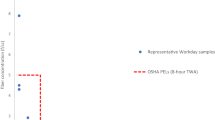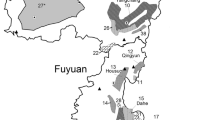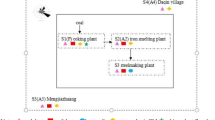Abstract
Although occupational benzene exposure of refinery workers has been studied for decades, no extensive analysis of historical industrial hygiene data has been performed focusing on airborne concentrations at specific refineries and tasks. This study characterizes benzene exposures at the ExxonMobil Baytown, TX, refinery from 1978 to 2006 to understand the variability in workers' exposures over time and during different job tasks. Exposures were grouped by operational status, job title, and tasks. More than 9000 industrial hygiene air samples were evaluated; approximately 4000 non-task (>3 h) and 1000 task-related (<3 h) personal samples were considered. Each sample was assigned to one of 27 job titles, 29 work areas, and 16 task bins (when applicable). Process technicians were sampled most frequently, resulting in the following mean benzene concentrations by area: hydrofiner (n=245, mean=1.3 p.p.m.), oil movements (n=286, mean=0.23 p.p.m.), reformer (n=575, mean=0.10 p.p.m.), tank farm (n=9, mean=0.65 p.p.m.), waste treatment (n=446, mean=0.13 p.p.m.), and other areas (n=460, mean=0.062 p.p.m.). The most frequently sampled task was sample collection (n=218, mean=0.40 p.p.m.). Job title and area did not significantly impact task-related exposures. Airborne concentrations were significantly lower after 1990 than before 1990. Results of this task-focused study may be useful when analyzing benzene exposures at other refineries.
This is a preview of subscription content, access via your institution
Access options
Subscribe to this journal
Receive 6 print issues and online access
$259.00 per year
only $43.17 per issue
Buy this article
- Purchase on Springer Link
- Instant access to full article PDF
Prices may be subject to local taxes which are calculated during checkout






Similar content being viewed by others
References
Armstrong T.W., Pearlman E.D., Schnatter A.R., Bowes S.M., Murray N., and Nicolich M.J. Retrospective benzene and total hydrocarbon exposure assessment for a petroleum marketing and distribution worker epidemiology study. Am Ind Hyg Assoc J 1996: 57: 333–343.
Baccarelli A., Pfeiffer R., Consonni D., Pesatori A.C., Bonzini M., Patterson D.G., Bertazzi P.A., and Landi M.T. Handling of dioxin measurement data in the presence of non-detectable values: overview of available methods and their application in Seveso chloracne study. Chemosphere 2005: 60: 898–906.
Buchet J.P., Van Eyken J., and Lauwerys R. Evalation de l′exposition au benzene des travailleurs preposes aux qais de chargement de l'essence dans une raffinerie. Cahiers de Medecine de Travail Cahiers Voor Arberdsgeneeskunde 1984: 21: 25–27.
Cherrie J.W. Are task-based exposure levels a valuable index of exposure for epidemiology? Ann Occup Hyg 1996: 40 (6): 715–722.
CONCAWE. A Survey of Exposures to Gasoline Vapour. Oil Companies European Organization for Environment, Health and Safety (CONCAWE), The Haguc, The Netherlands, 1987.
CONCAWE. Review of European oil Industry Benzene Exposure Data (1986–1992). Oil Companies European Organization for Environment, Health and Safety (CONCAWE), Brussels, 1994.
Glass D.C., Adams G.G., Manuell R.W., and Bisby J.A. Retrospective exposure assessment for benzene in the Australian petroleum industry. Ann Occup Hyg 2000: 44 (4): 301–320.
Glass D.C., Gray C.N., Adams G.G., Manuell R.W., and Bisby J.A. Validation of exposure estimation for benzene in the Australian petroleum industry. Toxicol Ind Health 2001: 17 (4): 113–127.
Glass D.C., Spurgeon A., Calvert I.A., Clark J.L., and Harrington J.M. Retrospective assessment of solvent exposure in paint manufacturing. Occup Environ Med 1994: 51 (9): 617–625.
HEI. Gasoline Vapor Exposure and Human Cancer: Evaluation of Existing Scientific Information and Recommendations for Future Research. Cambridge, MA: Health Effects Institute (HEI), 1998.
Helsel D. More than obvious: better methods for interpreting nondetect data. Environ Sci Technol 2005: 39: 419A–423A.
Helsel D.R., and Cohn T. Estimation of descriptive statistics for multiply censored water quality data. Water Resour Res 1988: 24: 1997–2004.
Henderson W., and Benjamin S. Standard Oil: The First 125 Years. Motorbooks International, New York, 1996. pp 12.
Hewett P. User Guide for IH Data Analyst. Available from: http://www.oesh.com/x%20Software/IHDA.php. 2007.
Huybrechts T., Thas O., Dewulf J., and Van Langenhove H. How to estimate moments and quantiles of environmental data sets with non-detected observations? A case study on volatile organic compounds in marine water samples. J Chrom 2002: 975: 123–133.
Ignacio J.S., and Bullock W.H., (eds.) A Strategy for Assessing and Managing Occupational Exposures. AIHA Press, Fairfax, VA, 2006. pp 415–421.
Lubin J.H., Colt J.S., Camann D., Davis S., Cerhan J.R., Severson R.K., Bernstein L., and Hartge P. Epidemiologic evaluation of measurement data in the presence of detection limits. Environ Health Perspect 2004: 112 (17): 1691–1696.
Meyers R.A., (ed.). Handbook of Petrolem Refining Processes. McGraw-Hill, New York, 2004.
National Institute of Occupational Safety and Health. NIOSH manual of analytical methods: aromatic Hydrocarbons, Method 1501. 4th edn. 2003.
Neter J., Wasserman W., and Kutner M.H. Applied Linear Statistical Models, 3rd edn. Irwin, Burr Ridge, IL, 1990.
Nordlinder R., and Ramnas O. Exposure to benzene at different work places in Sweden. Ann Occup Hyg 1987: 31 (3): 345–355.
OSHA 29 CFR 1910.1028: Benzene 1987.
OSHA. OSHA technical manual: petroleum refining processes. Vol Section IV, Chapter 2. Occupational Safety and Health Administration (OSHA) 2003.
Panko J.M., Gaffney S.H., Burns A.M., Unice K.M., Kreider M.L., Booher L.E., Gelatt R.H., Marshall J.R., and Paustenbach D.J. Occupational exposure to benzene at the ExxonMobil refinery at Baton Rouge, Louisiana (1977–2005). J Occup Environ Hyg 2009: 6 (9): 517–529.
Proctor D.M., Panko J.P., Liebig E.W., and Paustenbach D.J. Estimating historical occupational exposure to airborne hexavalent chromium in a chromate production plant: 1940–1972. J Occup Environ Hyg 2004: 1 (11): 752–767.
Rappaport S.M., Selvin S., and Waters M.A. Exposures to hydrocarbon components of gasoline in the petroleum industry. Appl Ind Hyg 1987: 2 (4): 148–154.
Runion H.E., and Scott L.M. Benzene exposure in the United States 1978–1983: an overview. Am J Ind Med 1985: 7: 385–393.
Segal D. Exxon-Mobil Merger Wins FTC Approval. Washington Post. Washington, D.C, 1999.
US EPA. 40 CFR 61 Subpart FF: National Emission Standards for Benzene in Waste Operations, 1989.
US EPA. Statistical Software ProUCL 4.0 for Environmental Applications for Data Sets with and without Nondetect Observations. Technical Support Center for Monitoring and Site Characterization, Las Vegas, NV, 2007. Available from: http://www.epa.gov/nerlesd1/tsc/tsc.htm.
Verma D.K., and des Tombe K. Measurement of benzene in the workplace and its evolution process, Part I: overview, history, and past methods. Am Ind Hyg Assoc J 1999: 60 (1): 38–47.
Verma D.K., Johnson D.M., Shaw M.L., and des Tombe K. Benzene and total hydrocarbons exposures in the downstream petroleum industries. Am Ind Hyg Assoc J 2001: 62 (2): 176–194.
Weaver N.K., Gibson R.L., and Smith C.W. Occupational exposure to benzene in the petroleum and petrochemical industries. In: Mehlman M.A. (Ed.). Advances in Modern Environmental Toxicology, Vol IV. Princeton Scientific Pub, 1983.
Acknowledgements
We thank Paul Scott of ChemRisk for his assistance with the statistical analysis and Matt Le and Kathleen Navarro for their assistance in assembling and organizing the electronic data.
Author information
Authors and Affiliations
Corresponding author
Ethics declarations
Competing interests
This work was funded by ExxonMobil, a firm that has been involved in the study of benzene for several decades. At least two of the authors have served or are likely to serve as expert witnesses for ExxonMobil on matters relating to industrial hygiene, exposure assessment, risk assessment, or toxicological issues related to benzene.
Rights and permissions
About this article
Cite this article
Gaffney, S., Panko, J., Unice, K. et al. Occupational exposure to benzene at the ExxonMobil Refinery in Baytown, TX (1978–2006). J Expo Sci Environ Epidemiol 21, 169–185 (2011). https://doi.org/10.1038/jes.2009.53
Received:
Accepted:
Published:
Issue Date:
DOI: https://doi.org/10.1038/jes.2009.53
Keywords
This article is cited by
-
Low personal exposure to benzene and 1,3-butadiene in the Swedish petroleum refinery industry
International Archives of Occupational and Environmental Health (2017)
-
Personal exposure to benzene and 1,3-butadiene during petroleum refinery turnarounds and work in the oil harbour
International Archives of Occupational and Environmental Health (2016)



